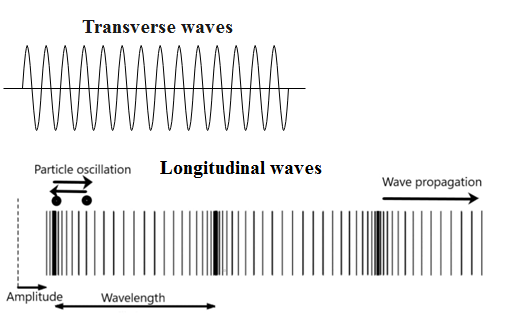
Give two examples of longitudinal waves.
Answer
543.9k+ views
Hint: This question is based on the concept of the type of mechanical wave, that is, the longitudinal waves. In this question, we are asked to give examples of the longitudinal waves. So, we will use examples like sound waves and ultrasound waves.
Complete answer:
The longitudinal waves are the types of mechanical waves. These move along the direction of their propagation.
The types of the longitudinal waves are sound waves and the ultrasound waves.
Sound waves: These waves are produced by the vibration of the moving particles. The speed of sound depends on the type of medium.
Ultrasound waves: These waves are produced by the transducer. These waves are useful in examining the internal organs of the body.
The other type of mechanical waves is the transverse waves. The diagram representing the transverse waves and the longitudinal waves is as follows.

The difference between the longitudinal waves and the transverse waves is as follows. The longitudinal waves move along the direction of its propagation, whereas, the transverse waves move perpendicular to the direction of its propagation. The longitudinal waves are made up of the refractions and compressions, whereas, the transverse waves are made up of troughs and crests. In any medium, such as the solid, liquid or the gas, the longitudinal waves can be produced, whereas, the transverse waves can only be produced on the surfaces of the solid and the liquids.
The examples of the longitudinal waves are the sound waves and the ultrasound waves.
Note: In this question, the examples of the longitudinal waves are asked. Even they can ask for examples of the transverse waves, as these are the types of mechanical waves. The theory of both types of mechanical waves should be known as discussed above to answer these types of theoretical questions.
Complete answer:
The longitudinal waves are the types of mechanical waves. These move along the direction of their propagation.
The types of the longitudinal waves are sound waves and the ultrasound waves.
Sound waves: These waves are produced by the vibration of the moving particles. The speed of sound depends on the type of medium.
Ultrasound waves: These waves are produced by the transducer. These waves are useful in examining the internal organs of the body.
The other type of mechanical waves is the transverse waves. The diagram representing the transverse waves and the longitudinal waves is as follows.

The difference between the longitudinal waves and the transverse waves is as follows. The longitudinal waves move along the direction of its propagation, whereas, the transverse waves move perpendicular to the direction of its propagation. The longitudinal waves are made up of the refractions and compressions, whereas, the transverse waves are made up of troughs and crests. In any medium, such as the solid, liquid or the gas, the longitudinal waves can be produced, whereas, the transverse waves can only be produced on the surfaces of the solid and the liquids.
The examples of the longitudinal waves are the sound waves and the ultrasound waves.
Note: In this question, the examples of the longitudinal waves are asked. Even they can ask for examples of the transverse waves, as these are the types of mechanical waves. The theory of both types of mechanical waves should be known as discussed above to answer these types of theoretical questions.
Recently Updated Pages
Why are manures considered better than fertilizers class 11 biology CBSE

Find the coordinates of the midpoint of the line segment class 11 maths CBSE

Distinguish between static friction limiting friction class 11 physics CBSE

The Chairman of the constituent Assembly was A Jawaharlal class 11 social science CBSE

The first National Commission on Labour NCL submitted class 11 social science CBSE

Number of all subshell of n + l 7 is A 4 B 5 C 6 D class 11 chemistry CBSE

Trending doubts
What is meant by exothermic and endothermic reactions class 11 chemistry CBSE

10 examples of friction in our daily life

One Metric ton is equal to kg A 10000 B 1000 C 100 class 11 physics CBSE

1 Quintal is equal to a 110 kg b 10 kg c 100kg d 1000 class 11 physics CBSE

Difference Between Prokaryotic Cells and Eukaryotic Cells

What are Quantum numbers Explain the quantum number class 11 chemistry CBSE




